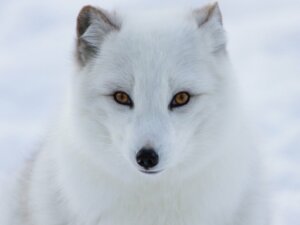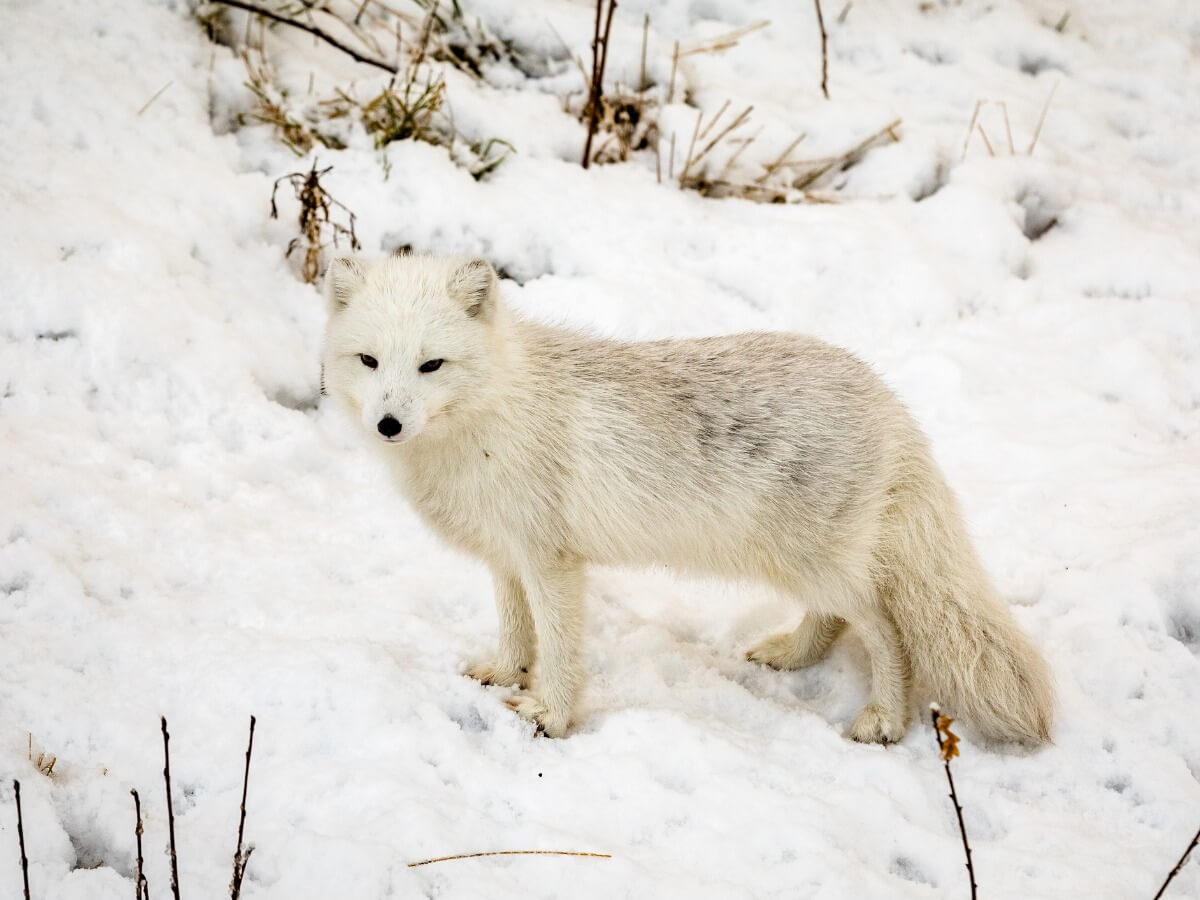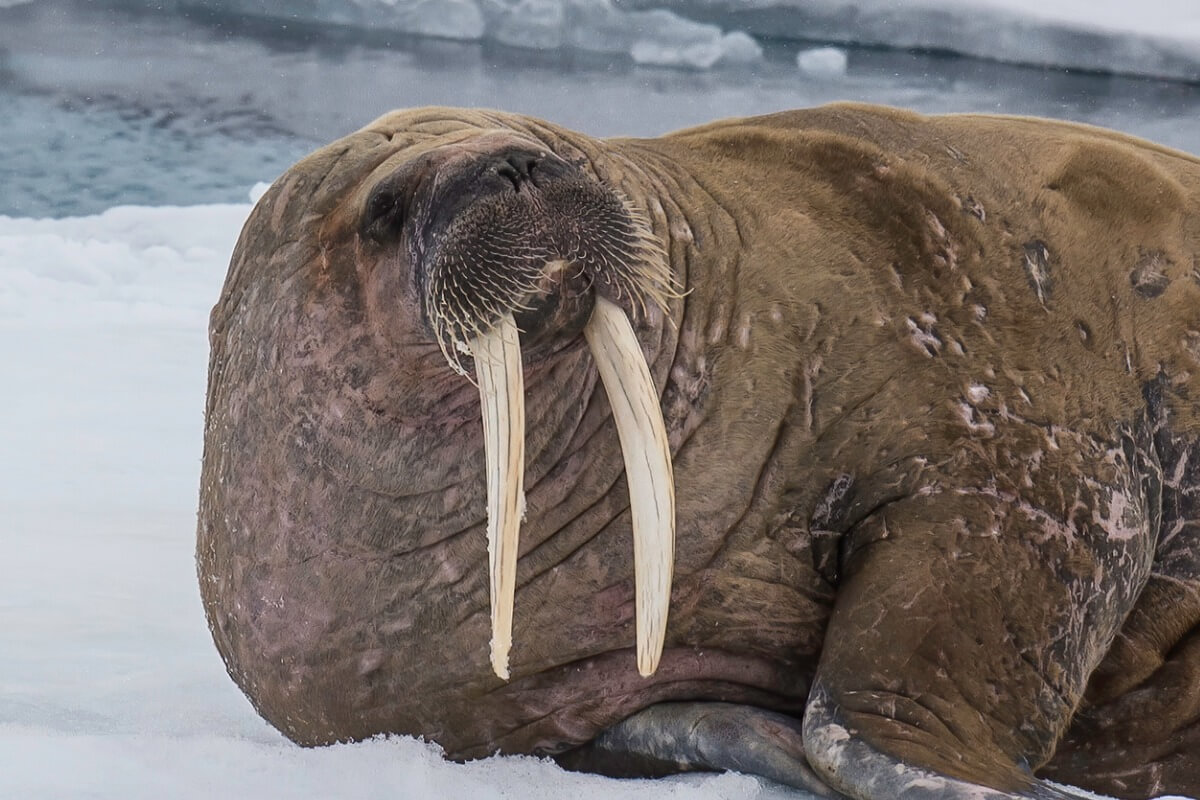5 Endangered Animals at the North Pole

The Arctic is experiencing the worst time of its history. Thawing, hunting, oil drilling and many more human actions are exposing more and more endangered animals at the North Pole. The species that inhabit this ecosystem are highly specialized to live in extremely cold conditions, which is why changes affect them severely.
The destruction of the environment is progressing three times faster in the Arctic than in the rest of the world. If you want to know which species are most affected by this situation, here you can read more about them. Time is running out…
The North Pole crisis
The Arctic Circle has been experiencing a climate crisis for many years now. The warnings began some time ago and we’ve been able to verify some of the consequences. The rise in sea level is noticeable (from 10 to 20 centimeters – 4 to 8 inches), there are more and more floods, abnormal frosts are appearing, and there are more and more heatwaves.
This region is facing many problems, but, in general terms, we can highlight the following:
- Thaw: The Poles are the refrigerator of the planet! As they melt and shrink, not only do the oceans cool, but all the heat that the ice returns to the atmosphere affects the rest of the planet, thus accelerating global warming.
- Emission of methane: This gas, which is so harmful to the atmosphere, is stored in large quantities within the permafrost. As this layer melts, the gas is released. As the thaw increases, this causes more methane emissions, speeding up the cycle more and more.
- Climatic instability: The consequences of this situation are complex, and it’s impossible to predict what anomalous phenomena we’ll experience in the future. In addition, experts assure us that its severity will increase.
5 endangered animals at the North Pole
The first victims of this crisis are the endangered animals at the North Pole. From the loss of usable ice space to the difficulty in finding food, these species are increasingly having trouble surviving in their own home. Here you can meet the most representative.
1. Polar bear (Ursus maritimus)
This marine mammal is perhaps the best-known species for its vulnerability. Polar bears are totally dependent on the North Pole ice sheet, both for movement and food. This species, which spends more time in the water than on land, takes longer and longer to return to the water, as each winter the water takes longer and longer to freeze.
The fact that polar bears have to take refuge on the shores makes it more likely that they’ll encounter the communities of humans that live there. This doesn’t usually end well for either of the two species. Unfortunately, the accessibility of these animals has increased illegal hunting.
60% of the living specimens are found in Canadian lands. The species is in a vulnerable situation.

2. The arctic fox (Alopex lagopus)
This spectacular mammal, which develops a snowy coat in winter to camouflage itself in the snow, usually feeds on the carrion left by polar bears. As these mammals have difficulty finding prey, the Arctic fox is forced to search for new sources of food.
As they enter new territories in search of game, Arctic foxes invade the lands of other species, such as those of the red fox (Vulpes vulpes). In this way, they become competitors to other predators and decompensate the new habitats they enter.
There are 4 subspecies of arctic fox. The species isn’t listed as “endangered” today, but its future is delicate.

3. Beluga (Delphinapterus leucas)
The beluga is the victim of a problem at the base of the food chain: the density of the algae that proliferate on the ice is decreasing with the melting of this material. There are fewer crustaceans to feed on them, and, in turn, the Arctic cod is also in danger, as it hunts them for survival.
The last link in the chain, the beluga (which feeds mainly on Arctic cod) is also suffering a decline as a result. In addition, in its range off the coast of Alaska it has to deal with maritime traffic and industrial pollution in its waters. Currently, it’s in danger of extinction.
This species was the target of commercial hunting during the 19th century and part of the 20th.

4. The Pacific walrus ( Odobenus rosmarus )
It is an endemic species of the Arctic seas. These mammals ascend to the ice sheets and coasts to rest, give birth, or suckle their young. Apart from the destruction of their habitat by the thaw, they have to face the hunt for their long tusks (which are made of ivory) and their body fat.
Prospecting for oil in its range damages the surrounding ecosystem, especially when there are accidental spills.

5. Ptarmigan (Lagopus muta)
Also known as the alpine grouse, this partridge is a very common species in the tundra of the North Pole. As the ice retreated, the snow partridges sought refuge in mountainous massifs, where they were isolated. As they’re forced to go further and further south (they’re even seen in the Spanish Pyrenees), their numbers have been decreasing. Unfortunately, populations are becoming increasingly fragmented.
There are 23 subspecies of ptarmigan.
The Arctic is experiencing the worst time of its history. Thawing, hunting, oil drilling and many more human actions are exposing more and more endangered animals at the North Pole. The species that inhabit this ecosystem are highly specialized to live in extremely cold conditions, which is why changes affect them severely.
The destruction of the environment is progressing three times faster in the Arctic than in the rest of the world. If you want to know which species are most affected by this situation, here you can read more about them. Time is running out…
The North Pole crisis
The Arctic Circle has been experiencing a climate crisis for many years now. The warnings began some time ago and we’ve been able to verify some of the consequences. The rise in sea level is noticeable (from 10 to 20 centimeters – 4 to 8 inches), there are more and more floods, abnormal frosts are appearing, and there are more and more heatwaves.
This region is facing many problems, but, in general terms, we can highlight the following:
- Thaw: The Poles are the refrigerator of the planet! As they melt and shrink, not only do the oceans cool, but all the heat that the ice returns to the atmosphere affects the rest of the planet, thus accelerating global warming.
- Emission of methane: This gas, which is so harmful to the atmosphere, is stored in large quantities within the permafrost. As this layer melts, the gas is released. As the thaw increases, this causes more methane emissions, speeding up the cycle more and more.
- Climatic instability: The consequences of this situation are complex, and it’s impossible to predict what anomalous phenomena we’ll experience in the future. In addition, experts assure us that its severity will increase.
5 endangered animals at the North Pole
The first victims of this crisis are the endangered animals at the North Pole. From the loss of usable ice space to the difficulty in finding food, these species are increasingly having trouble surviving in their own home. Here you can meet the most representative.
1. Polar bear (Ursus maritimus)
This marine mammal is perhaps the best-known species for its vulnerability. Polar bears are totally dependent on the North Pole ice sheet, both for movement and food. This species, which spends more time in the water than on land, takes longer and longer to return to the water, as each winter the water takes longer and longer to freeze.
The fact that polar bears have to take refuge on the shores makes it more likely that they’ll encounter the communities of humans that live there. This doesn’t usually end well for either of the two species. Unfortunately, the accessibility of these animals has increased illegal hunting.
60% of the living specimens are found in Canadian lands. The species is in a vulnerable situation.

2. The arctic fox (Alopex lagopus)
This spectacular mammal, which develops a snowy coat in winter to camouflage itself in the snow, usually feeds on the carrion left by polar bears. As these mammals have difficulty finding prey, the Arctic fox is forced to search for new sources of food.
As they enter new territories in search of game, Arctic foxes invade the lands of other species, such as those of the red fox (Vulpes vulpes). In this way, they become competitors to other predators and decompensate the new habitats they enter.
There are 4 subspecies of arctic fox. The species isn’t listed as “endangered” today, but its future is delicate.

3. Beluga (Delphinapterus leucas)
The beluga is the victim of a problem at the base of the food chain: the density of the algae that proliferate on the ice is decreasing with the melting of this material. There are fewer crustaceans to feed on them, and, in turn, the Arctic cod is also in danger, as it hunts them for survival.
The last link in the chain, the beluga (which feeds mainly on Arctic cod) is also suffering a decline as a result. In addition, in its range off the coast of Alaska it has to deal with maritime traffic and industrial pollution in its waters. Currently, it’s in danger of extinction.
This species was the target of commercial hunting during the 19th century and part of the 20th.

4. The Pacific walrus ( Odobenus rosmarus )
It is an endemic species of the Arctic seas. These mammals ascend to the ice sheets and coasts to rest, give birth, or suckle their young. Apart from the destruction of their habitat by the thaw, they have to face the hunt for their long tusks (which are made of ivory) and their body fat.
Prospecting for oil in its range damages the surrounding ecosystem, especially when there are accidental spills.

5. Ptarmigan (Lagopus muta)
Also known as the alpine grouse, this partridge is a very common species in the tundra of the North Pole. As the ice retreated, the snow partridges sought refuge in mountainous massifs, where they were isolated. As they’re forced to go further and further south (they’re even seen in the Spanish Pyrenees), their numbers have been decreasing. Unfortunately, populations are becoming increasingly fragmented.
There are 23 subspecies of ptarmigan.
All cited sources were thoroughly reviewed by our team to ensure their quality, reliability, currency, and validity. The bibliography of this article was considered reliable and of academic or scientific accuracy.
- Dirzo, R., Young, H. S., Galetti, M., Ceballos, G., Isaac, N. J., & Collen, B. (2014). Defaunation in the Anthropocene. science, 345(6195), 401-406.
- Davidson, S. C., Bohrer, G., Gurarie, E., LaPoint, S., Mahoney, P. J., Boelman, N. T., … & Hebblewhite, M. (2020). Ecological insights from three decades of animal movement tracking across a changing Arctic. Science, 370(6517), 712-715.
- SEO/BirdLife. (2018, 4 mayo). Lagópodo alpino. https://seo.org/ave/lagopodo-alpino/
- Moyano, A. O. (2017). Ártico: La última frontera. Cambio 16, (2242), 20-25.
-
Lowry, L., Reeves, R. & Laidre, K. 2017. Delphinapterus leucas. The IUCN Red List of Threatened Species 2017: e.T6335A50352346. https://dx.doi.org/10.2305/IUCN.UK.2017-3.RLTS.T6335A50352346.en. Downloaded on 17 August 2021.
This text is provided for informational purposes only and does not replace consultation with a professional. If in doubt, consult your specialist.








